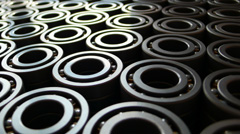
ceramic roller silicon nitride roller si3n4 roller zirconia roller zro2 roller
ceramic bearing silicon nitride bearing si3n4 bearing zirconia bearing zro2 bearing silicon carbide bearing sic ball aluminum oxide bearing al2o3 bearing full ceramic bearing ceramic ball bearing ceramic roller bearing
hybrid ceramic bearing hybrid ceramic ball bearing hybrid ball bearing hybrid roller bearing ceramic hybrid bearing ceramic hybrid ball bearing
![]()

General
The advanced structural ceramic materials feature different mechanical, physical and chemical properties from metals, as well as electrical properties. Extreme high hardness, low density (low gravity), physical stability, extreme heat resistance, chemical inertness, and superior electrical properties. As such, they are highly resistant to melting, bending, stretching, corrosion and wear, much better than metals. Silicon nitride (Si3N4), zirconia (ZrO2), silicon carbide (SiC) and Alumina (Al2O3) are currently four of the most widely studied structural ceramics. They are already being used in significant amounts in applications such as bearing components (balls, rollers, races), wear washers, shafts, sleeves, pumps, extrusion dies, oil field components, tool bits, liquid metal filters, precombustion chambers, grinding media, etc. Despite possessing the strength and modulus values which are equal to or better than metals, with the added advantage of low density and chemical inertness, the ceramics are yet to be used on a large scale for demanding structural applications. This is mainly due to their brittle fracture behavior (low fracture toughness) and low reliability. With the progress of science and technology, more and more application and design engeers introduces ceramic bearings and ceramic structural parts into the applications of severe environments and extreme conditions. Our engineers are here to help you on figuring out the better solutions for your special application requirements.
|
 The ceramic materials for making mechanical parts are called "advanced structural ceramic", which came on to the scene in the 20th century as the materials systems became more refined and special compounds. They are new ceramic materials and much different from the "traditional ceramic" such as tiles, porcelain, sanitaryware etc. These advanced structural ceramics are distinguished by their high chemical purity, special processing and high values of the useful properties.
The ceramic materials for making mechanical parts are called "advanced structural ceramic", which came on to the scene in the 20th century as the materials systems became more refined and special compounds. They are new ceramic materials and much different from the "traditional ceramic" such as tiles, porcelain, sanitaryware etc. These advanced structural ceramics are distinguished by their high chemical purity, special processing and high values of the useful properties.